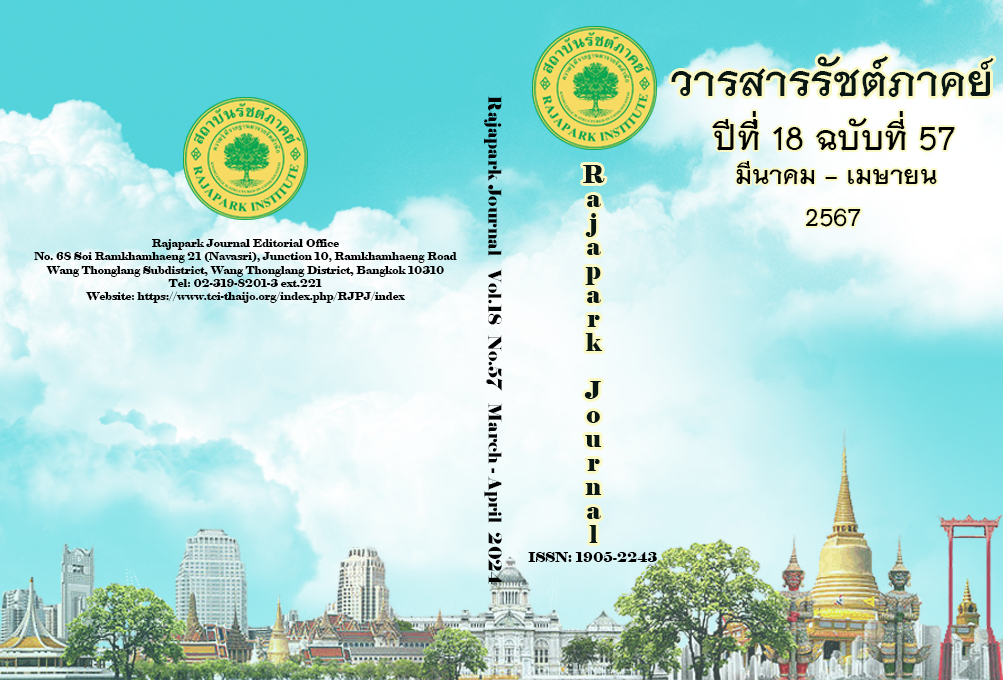Knowledge Frontier of Neurodesign in Education
Main Article Content
Abstract
This academic article aimed to illustrate the knowledge frontier of Neurodesign in education. It concludes that Neurodesign in education integrates neuroscience, engineering, and design thinking, covering three levels: (1) The ideal Neurodesign uses Neurodesign to design and develop educational theories, ideals, and values. (2) Operational Neurodesign uses Neurodesign to design and develop various procedures consisting of instructional techniques, teaching methods, strategies, and resources. This level also includes the social and surrounding contexts, such as people, places, and products. (3) The learning outcomes of Neurodesign use Neurodesign to design and develop the learning outcomes, comprising the learning outcomes assessment tools and measurement and evaluation procedures.
Article Details

This work is licensed under a Creative Commons Attribution-NonCommercial-NoDerivatives 4.0 International License.
Views and opinions appearing in the Journal it is the responsibility of the author of the article, and does not constitute the view and responsibility of the editorial team.
References
Ahram, T., Falcão, C., Barros, R. Q., Soares, M. M., & Karwowski, W. (2016). Neurodesign: Applications of neuroscience in design and human-system interactions. In Soares, M. & Rebelo F. (Eds.), Ergonomics in Design: Methods and Techniques. (pp. 481–495). CRC Press. https://doi.org/10.1201/9781315367668
Durnez, J., Blair, R., & Poldrack, R. A. (2017). Neurodesign: Optimal Experimental Designs for Task fMRI. bioRxiv, March 23, 2017. https://doi.org/10.1101/119594
Gallace, A. (2016). Neurodesign: A new frontier of packaging and product design. Packaging Digest, 53(1), 22–23.
Auernhammer, J., Sonalkar, N., & Saggar, M. (2021). NeuroDesign: From Neuroscience Research to Design Thinking Practice. In Meinel, C., & Leifer, L. Design Thinking Research, (pp.347-355). Springer Cham. https://doi.org/10.1007/978-3-030-62037-0_16
Jeffrey H, D., Hal B, G., & Clayton M, C. (2009). The innovator’s DNA. O'Reilly Media, Inc.
Liu, W., Jin, Y., Li, B., Lyu, Z., Pan, W., Wang, N., & Zhao, X. (2020). NeuroDesign: Making Decisions and Solving Problems Through Understanding of the Human Brain. In International Conference on Human-Computer Interaction, 12200, 199–208.
Ma, Q., Bian, J., Fu, H., Pei, G., & Zhang, M. (2012 a). Production process improvement based on neurodesign. In International Conference on Value Engineering and Management: Innovation in the Value Methodology, ICVEM 2012, 137-139.
Ma, Q., Fu, H., & Wang, S. (2012 b). Neural value analysis: A new direction for neurodesign and neuroergonomics. In International Conference on Value Engineering and Management: Innovation in the Value Methodology, ICVEM 2012, 134–136.
Ma, Q., Huang, Y., Wang, X., & Li, N. (2014). Event-related potential P3 as an index of aesthetic evaluation in neurodesign. WIT Transactions on Information and Communication Technologies, 46(3), 2309–2313. https://doi.org/10.2495/ISME20133113
Monestina, N. G., Berdasco, D. P., Albiñana, M. B. J., & Royo, T. M. (2014). Emotional design through measurement of sychophysiological and behavioral parameters: Taking steps towards neurodesign. In The 9th International Conference on Design & Emotion. 325–331.
Nuffield Department of Clinical Neurosciences. (2024). Introduction to FMRI. https://www.ndcn.ox.ac.uk/divisions/fmrib/what-is-fmri/introduction-to-fmri.
Okinawa Institute of Science and Technology. (2024). EEG hyperscanning. https://groups.oist.jp/ecsu/eeg-hyperscanning.
Paoletti, A., & Imbesi, L. (2021). A Tool for Neurodesign: Interpreting Neurophysiological Data from Designers’ Perspective. Design Principles and Practices: An International Journal—Annual Review, 15(1), 55-61. https://doi.org/10.18848/1833-1874/cgp/v15i01/55-61
Lucia, R.R., Francisco, G.A., De Vinuesa, G., de Las Heras, A., & Antonio, C.R. (2020). Neurodesign: A proposal for its development from cognitive neuroscience. In 24th International Congress on Project Management and Engineering. 848-860.
Rhodes, M. (1961). An Analysis of Creativity. The Phi Delta Kappan, 42(7), 305–310.
Srikoon, S. (2024). Educational Neuroscience: Definition, Scope, and Neuroimaging. Trends of Humanities and Social Sciences Research, 12(1).
Standford University. (2024). Neurodesign Research. https://neurodesign.stanford.edu/
Tripp, B., & Shortlidge, E. E. (2019). A framework to guide undergraduate education in interdisciplinary science. CBE Life Sciences Education, 18(2), 1-12. https://doi.org/10.1187/cbe.18-11-0226
University of Potsdam. (2024). Neurodesign. https://hpi.de/neurodesign/home.html?fbclid= IwAR3io4zA9I_IxunfWu4mShjTuGSU-DuKKwToDcaUCIXrs7xcKMgSEtddVok
von Thienen, J., Kolodny, O., & Meinel, C. (2023). Neurodesign: The Biology, Psychology, and Engineering of Creative Thinking and Innovation. In Rezaei, N. (Eds). Brain, Decision Making and Mental Health. Integrated Science, 12. Springer, Cham. https://doi.org/10.1007/978-3-031-15959-6_29
von Thienen, J., Szymanski, C., Santuber, J., Plank, S.I., Rahman, S., Weinstein, T., Owoyele, B., Bauer, M., & Meinel, C. (2021). Neurodesign Live. In Meinel, C., & Leifer, L. Design Thinking Research. (pp.357-425). Springer Cham.


